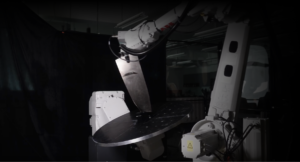table of contents
- Heading 1
- Heading 1
- Heading 1
share this
3D scanning in industrial automation isn’t just about hardware specs; it’s also a critical part of accurate part reconstruction for robotic workflows. When deployed on industrial robots, the effectiveness of a scan is determined not solely by the tool in use, but by the scanning strategy employed. Geometry, size, complexity, and symmetry all influence how 3D data should be acquired to ensure precise downstream processes like surface finishing, inspection, welding, and beyond.
Whether it’s an aerospace blade, pressure vessel, or mechanical casting, selecting the wrong strategy can result in incomplete data capture.
This is where an integrated approach becomes critical. The Augmentus system empowers users to seamlessly combine these scanning strategies, maximizing both scanning efficiency and accuracy. This article explores each method and explains how combining these strategies can provide complete 3D scans across various applications.
Scanning Strategies: Technical Breakdown
1. Linear Rail Scanning
Mechanism:
Linear rail scanning involves moving the scanner along a straight path using a rail system. This method is ideal for scanning large, flat surfaces or elongated objects, where consistent, linear motion ensures comprehensive capture with minimal distortion.
Technical Advantages:
- Uniform Coverage: Linear motion ensures consistent coverage across long or flat surfaces, making it highly effective for scanning panels, walls, or other large-scale objects.
- Accuracy Over Large Areas: By minimizing misalignment through straight, consistent motion, linear rail scanning ensures high accuracy over extended distances.
- Ideal for Planar Geometries: Best suited for objects with flat geometries, such as beams, sheets, or large mechanical parts.
2. Rotary Scanning
Mechanism:
Rotary scanning works by rotating the object using a positioner while the scanner captures data at discrete angles. This approach is particularly useful for cylindrical or symmetrical objects, allowing the scanner to capture the object from all angles.
Technical Advantages:
- Complete Surface Coverage at Discrete Angles: Rotary scanning captures the object from multiple, discrete angles by rotating it on a positioner.
- Suitable for More Symmetrical Shapes: Ideal for objects such as pipes, shafts, or wheels.
3. Multi-Angle Scanning
Mechanism:
Multi-angle scanning involves repositioning the scanner or object to capture surfaces from different viewpoints. This method is essential for capturing complex geometry, undercuts, or recessed areas not visible from a single angle.
Technical Advantages:
- Captures Complex Geometries: Ensures that all surfaces, including hidden or occluded areas, are captured.
- Detailed Surface Capture: Ideal for objects with intricate shapes, such as mechanical parts with deep grooves, overhangs, or internal cavities, ensuring accurate surface data.
- Flexible for Different Object Sizes: Adaptable for both small intricate parts and large, complex structures.
Combining Strategies: When One Is Not Enough
In many cases, using just one scanning strategy may not be enough to capture the entire surface of an object, especially when dealing with complex shapes, hidden features, or large dimensions. By combining linear rail, rotary, and multi-angle scanning, users can ensure that every part of the object is captured, resulting in a complete and detailed 3D model.
For instance, linear rail scanning can be used to capture large, flat sections of an object, while multi-angle scanning is employed to capture intricate details or recessed areas.
Similarly, rotary scanning can be used for symmetrical sections of an object, while multi-angle scanning helps cover complex, hidden areas. Combining these methods enables comprehensive and accurate data collection
Without a system capable of orchestrating this, users are forced to manually stitch data sets, which is time-consuming and error-prone.
Where Augmentus Adds Value: Scanning Strategy Built In
By integrating robot kinematics, motion profiling, and path optimization, Augmentus ensures that different strategies can work together to optimize data collection.
Key Capabilities:
- Seamless strategy switching: The Augmentus system allows users to switch seamlessly between scanning strategies depending on the object’s requirements.
- Automatic Alignment: When multiple strategies are employed, Augmentus ensures that scans are automatically aligned and stitched together, reducing the need for manual adjustments and ensuring a seamless final 3D model.
- Consistent Accuracy Across Methods: Whether using linear, rotary, or multi-angle scanning, Augmentus maintains consistent accuracy, enabling users to switch between methods without sacrificing precision.
Summary Table: Choosing the Right Scanning Strategy
The choice of scanning strategy—or combination of strategies—depends on the object’s shape, size, and complexity. Here’s a quick guide to help you decide:
| Strategy | Best For |
| Linear Rail | Long, flat, or simple objects like beams, panels, or large surfaces. |
| Rotary | Cylindrical or symmetrical objects like pipes, wheels, or objects with rotational symmetry. Works well with scanner movement along a straight path for long or complex parts. |
| Multi-Angle | Objects with complex geometries, recessed areas, or intricate details that require scanning from multiple viewpoints. |
| Combined Approach | Objects with varied geometry use a combination of strategies to ensure complete coverage. Linear rail scanning captures large, flat sections, rotary scanning handles symmetrical features, and multi-angle scanning captures hidden or complex areas. |
Final Word
Scanning strategies like linear rail, rotary, and multi-angle each offer distinct advantages, but combining them provides the most comprehensive 3D scans. The Augmentus system allows users to seamlessly integrate these strategies into their scanning workflows, ensuring each method works together to deliver high-precision, detailed 3D models.
Whether scanning large flat surfaces, cylindrical objects, or intricate geometries, Augmentus ensures complete and accurate scans across all applications.



